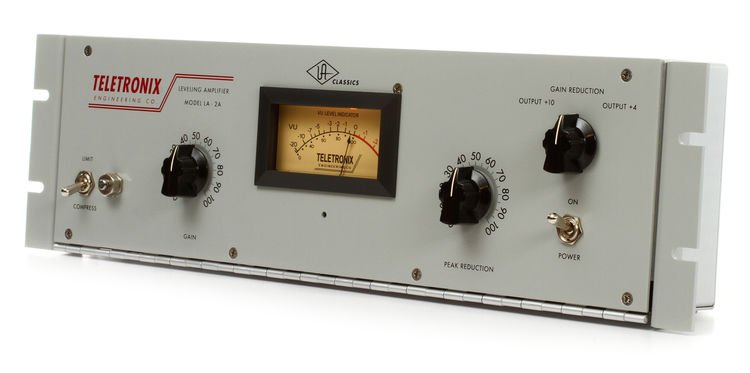How to Use Compression Like a Painter

Compression isn’t just for controlling dynamic range. A collection of compressors can act like an assortment of paintbrushes, adding detail, or softening the focus.
When I started out in the studio, I saw a compressor as the unit that regulates the gain of a signal, keeping it from getting too far out of hand.
To a young Rick Slater, the ratio interacted with all the other controls in contributing to that simple end.
These days, I don’t think of a compressor as a mere gain regulation unit anymore. Just recently, I had an intern comment that it seemed like I was using my compressors not to control the gain, but to sculpt the sound. (Would-be interns and assistants should note the level of attention and detail that this one brought to the table.)
I consider the sound a particular unit will impart on the track, how I can shape the sound, and more importantly what kind of impact the resulting track should have.
For example: Since a leveling amplifier like a Teletronics LA-2A has a slower rate of attack, an acoustic guitar’s attack comes through before the compressor can really squash it. By design the leveling amp is also increasing the level of quieter signal so as the attack comes through the sustain gets picked up by the compressor and held there at that increased level, giving the track more body.
To really get to the heart of the matter, one needs to understand the elements of a sound wave. The initial edge of the wave is known as the “attack”. In most instances the end of the attack will represent the loudest peak of the wave. This is followed by “decay” where the level will drop down before leveling off to what we refer to as “sustain”. As the energy dissipates the sound diminishes in what we call “release”.
It takes a lot of time with compressors before you will learn to hear the subtle nuances of difference between models, or settings. Regardless of what kind of compressor I end up using, one of the things I always listen for is how it affects the attack and the sustain of the sound I am processing. Is it increasing or decreasing one or the other?
This is much more than just a technical question. It’s a creative one. This is where I start to listen to my sound field like a painter looks at his canvas, considering the contrast between foreground and background.
I’ll ask myself: Where does this compressor place the sound in the sound field? Is it pushing it back by decreasing the attack or making it pop forward by allowing the natural attack but pushing the sustain up forward towards the listener? Listen closely and you can hear subtle changes start to happen before you even see much gain reduction.
When using compressors that are more complex than the classic LA-2A (which has a fixed, program-dependent response), an important consideration is in setting your attack and release speeds.
Once your signal passes through the threshold, these settings control how the compressor reacts. It is important that you choose the right speed of attack to meet your goals. How much attack should pass through before the compressor hits? Does the sound need to be pushed back further by reducing the attack, or should it leap out at the listener, by letting more attack get through?
When setting release times, it ‘s important to be sure that too-long a release doesn’t make the track sound like it’s dragging. On the other hand, too fast a release setting can cause too much grittiness or even a near nauseating “pumping sound.”
Another option to consider is parallel compression. By sending signal to a compressor set up a second, parallel channel, we can use more extreme settings to sculpt a sound and then blend that back into the mix with the original signal which still retains its original dynamics. Many plugins provide the user with a blend or “mix” function allowing you to perform parallel compression in-line, all on one track.
Hopefully you will start to consider your compression choices with an eye to painting your own picture the next time you reach for a compressor. In future installments I will discuss the various types of compressors and how and when you might choose to use them.
Rick Slater is a freelance audio professional, writer, and educator in the NYC Metropolitan area. You can reach him at http://www.audiobyrickslater.com.
Please note: When you buy products through links on this page, we may earn an affiliate commission.







